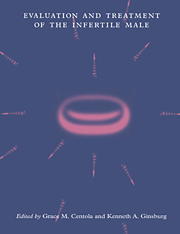Book contents
- Frontmatter
- Contents
- Preface
- List of contributors
- 1 Andrology
- 2 Sperm–egg interaction
- 3 Routine semen analysis
- 4 Computer-aided sperm analysis: a critical review
- 5 Antisperm antibodies: diagnosis and treatment
- 6 The sperm penetration assay
- 7 Intrauterine insemination for male factor
- 8 Processing human semen for insemination: comparison of methods
- 9 New assays for evaluating sperm function
- 10 Assisted reproductive technology for male factor infertility
- 11 Microinjection techniques for male infertility
- 12 Therapeutic donor insemination: screening, indications and technique
- 13 Endocrine assessment and hormone treatment of the infertile male
- 14 The urologic evaluation of the infertile male
- 15 Azoospermia: the diagnosis and treatment
- 16 White blood cells in semen and their impact on fertility
- 17 Psychological aspects of male infertility: lifting the shroud of shame
- 18 Evaluation of the female partner
- Index
5 - Antisperm antibodies: diagnosis and treatment
Published online by Cambridge University Press: 16 September 2009
- Frontmatter
- Contents
- Preface
- List of contributors
- 1 Andrology
- 2 Sperm–egg interaction
- 3 Routine semen analysis
- 4 Computer-aided sperm analysis: a critical review
- 5 Antisperm antibodies: diagnosis and treatment
- 6 The sperm penetration assay
- 7 Intrauterine insemination for male factor
- 8 Processing human semen for insemination: comparison of methods
- 9 New assays for evaluating sperm function
- 10 Assisted reproductive technology for male factor infertility
- 11 Microinjection techniques for male infertility
- 12 Therapeutic donor insemination: screening, indications and technique
- 13 Endocrine assessment and hormone treatment of the infertile male
- 14 The urologic evaluation of the infertile male
- 15 Azoospermia: the diagnosis and treatment
- 16 White blood cells in semen and their impact on fertility
- 17 Psychological aspects of male infertility: lifting the shroud of shame
- 18 Evaluation of the female partner
- Index
Summary
Immunology of sperm and seminal plasma
During the onset of spermatogenesis at puberty, new developmental antigens make their appearance on the sperm surface (Ishahakia, 1988). Because immune tolerance for self-antigens is expressed neonatally, these newly appearing sperm antigens may be immunogenic. It has been theorized that sequestration of developing sperm by the blood–testis barrier prevents the generation of autoantibodies to sperm (Dym, 1973). Additional evidence has recently been presented that certain testicular auto-antigens exist outside the blood–testis barrier and are accessible to circulating antibodies and immune processing cells. A population of suppressor T lymphocytes has also been identified in the epididymis, suggesting that active immune suppression may play a role in preventing the development of autoimmunity to sperm (El-Demiry & James, 1988).
Immunoinhibitory substances of high and low molecular weight have been detected within seminal plasma (Lord et al., 1977). One factor that is highly immunosuppressive is prostaglandin PGE2, which is present in high concentrations in semen (Quayle et al., 1989; Szymaniec et al., 1987). The masking of immunodominant antigens on the sperm surface by seminal-plasma-derived coating factors may also play a role. This is suggested by the relative lack of antigenicity of epididymal mouse sperm that have been incubated in seminal fluid as opposed to saline. Semen has also been found to contain populations of suppressor and helper T lymphocytes, which may play roles in modulating the immune response in the vagina, by the secretion of locally active products (Witkin, 1988).
- Type
- Chapter
- Information
- Evaluation and Treatment of the Infertile Male , pp. 42 - 57Publisher: Cambridge University PressPrint publication year: 1996
- 1
- Cited by

